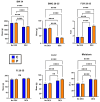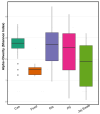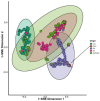Bacillus amyloliquefaciens Probiotics Mix Supplementation in a Broiler Leaky Gut Model
- PMID: 38399823
- PMCID: PMC10892336
- DOI: 10.3390/microorganisms12020419
Bacillus amyloliquefaciens Probiotics Mix Supplementation in a Broiler Leaky Gut Model
Abstract
The supplementation of antimicrobial growth promoters (AGPs) has been banned in many countries because of the emergence of antimicrobial-resistant pathogens in poultry products and the environment. Probiotics have been broadly studied and demonstrated as a promising AGP substitute. Our study is centred on the effects of a multi-strain Bacillus-based probiotic product on broiler production performance and gut microbial profile in a dexamethasone-induced leaky gut challenge. Two hundred and fifty-six broiler chicks were hatched and randomly assigned into four groups (wheat-soybean meal basal diet (BD) = non-supplemented control (C), BD supplemented with dexamethasone in week 4 (CD), BD containing a probiotic from day one (P), and BD containing a probiotic from day one and supplemented with dexamethasone during challenge week 4 (PD)). The production performance and caecal, gizzard, jejunal lumen and jejunal mucosa swab microbiota were studied by 16S rRNA gene sequencing. The Bacillus probiotic product significantly improved production performance and altered caecal gut microbiota (p ≤ 0.05), but no significant impact on microbiota was observed in other gut sections.
Keywords: Bacillus; broilers; colonisation; dexamethasone; gut microbiota; probiotics.
Conflict of interest statement
The authors declare no conflicts of interest. D.H., J.v.H., and X.C. are employed by Bioproton Pty Ltd., D.S. and Y.S.B. received funding from Bioproton Pty Ltd. A.K. and T.T.H.V. have no conflicts of interest to declare.
Figures







References
-
- Ritchie H., Rosado P., Roser M. Meat and Dairy Production. Our World in Data; Oxford, UK: 2017.
-
- OECD. Food and Agriculture Organization of the United Nations . OECD-FAO Agricultural Outlook 2021–2030. OECD Publishing; Paris, France: 2021.
Grants and funding
LinkOut - more resources
Full Text Sources

